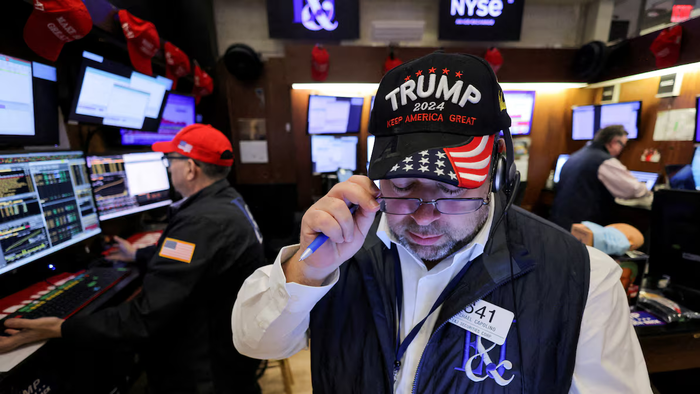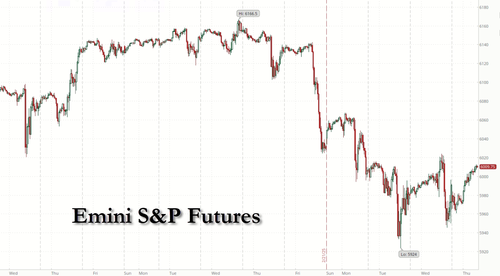


US equity futures are higher post-NVDA, though the stock’s reaction was a bit muted with the stock rising ~2% pre-market, a far cry from the 10% swing that was priced in by straddles ahead of earnings (and why both puts and calls will expire worthless). As of 8:00am ET, S&P futures are up 0.6%, and Nasdaq futures rise 0.8%, with all Mag7 stocks higher, and Semis and Fins also stronger. Bond yields are up 5bps from 2s to 30s with USD poised to have its strongest day in 5 sessions as yen drops sharply after stops are triggered around 149.40. Commodites are weaker ex-Energy although WTI remains below $70/bbl. Today’s macro data focus is on Durable/Cap Goods and Jobless data. Notably, both Asian and European stocks are weaker today, prompting JPM to ask if "this the beginning of a rotation back to US TMT?"
In premarket trading, Nvidia ticks 2.4% higher after the chipmaker delivered good-but-not-great quarterly numbers. As for the other Magnificent Seven stocks, Tesla and Meta Platforms are top gainers (Alphabet +0.8%, Amazon +1.7%, Apple -0.1%, Microsoft +0.4%, Meta Platforms +1.5% and Tesla +2%). EBay tumbled 7% after projecting sales for the current quarter that missed analysts’ estimates, guidance that Chief Executive Officer Jamie Iannone attributed to soft demand in Germany and the UK. Snowflake (SNOW) jumps 12% after the cloud-computing company gave an outlook for product revenue that is above the analyst consensus. Salesforce (CRM) shares fall 3% after the software company gave an outlook that is weaker than expected. Here are some other notable premarket movers:
Nvidia’s largely positive, if hardly blowout. results come only a month after Chinese startup DeepSeek challenged US Big Tech’s artificial intelligence spending with its cheaper AI model. The picture for tech investors is made even more complex by US President Donald Trump’s administration pressuring allies to escalate curbs on China’s semiconductor industry. “While we continue to highlight volatility in the near term amid macro uncertainty, US-China tensions, tariffs, and geopolitical developments, we believe the broader AI trend remains intact,” said Mark Haefele, chief investment officer at UBS Global Wealth Management.
Investors are also confronting a murky outlook for US trade tariffs, after Trump threatened to impose 25% levies on European Union imports sending stocks lower by 0.4%, and off its record high, with the auto sector the biggest laggard. Trump gave contradictory statements Wednesday on the implementation of tariffs, keeping investors guessing. A White House official said the European levies could affect all exports from the block, or only specific sectors. The US remains on track to put levies on Mexico and Canada, however it is unclear if they are going to be enacted in March.
“The market wants to see the implementation to price in the worst,” said Michael Nizard of Edmond de Rothschild Asset Management. “Up until now, it was negotiations and the market doesn’t want to correct more.”
Commenting on the outlook for US stocks, JPMorgan's Ilan Benhamou said they will struggle early March amid weaker economic data before they rally again later in spring. “In the immediate future, things are too messy for stocks to break out, and I think the market is stuck,” Benhamou, who works in equity derivatives sales, wrote in a note to clients.
Elsewhere, Initial jobless claims and revised fourth-quarter gross domestic product numbers feature in a flurry of readings due later that investors will parse for any further evidence of slowing growth. Money markets have boosted Federal Reserve easing bets to fully price two quarter-point cuts this year compared to just one reduction two weeks ago.
European stocks were left behind in today bounce, after US President Trump said he would impose 25% tariffs on imports from the European Union. The Stoxx 600 is off the lows but still down 0.5%, led lower by automakers as European stocka trim yesterday’s record high in early Thursday trading, with declines led by automakers on renewed tariff uncertainty from the US. The region’s most significant movers are driven by company earnings in another busy report day in Europe, with Rolls-Royce and Technip surging, and Ocado and WPP sinking on their respective reports. Here are the biggest movers Thursday:
Earlier in the session, Asian stocks fell as equities in Hong Kong pulled back after a strong rally spurred by a slew of positive developments. The MSCI Asia Pacific Index declined as much as 0.5%, weighed by tech firms including Xiaomi and Alibaba. Shares dropped in Taiwan and South Korea, while those in Japan rose. Investor sentiment remained cautious amid mixed messages from Donald Trump and uncertainty over US tariffs on Chinese imports. Trump expressed interest in having China invest in the US just days after he ordered restrictions to Chinese spending in some sectors. “The key uncertainty remains on how much of these tariff threats will eventually materialize, though broad resilience in market sentiments suggests that market participants are still expecting somewhat of a negotiated outcome with minimal tariff implementation,” Yeap Jun Rong, market strategist at IG Asia Pte in Singapore, wrote in a note. Earnings from Nvidia also failed to impress investors, with the company’s shares falling in after-hours trading after the chipmaker delivered results.
In rates, Treasuries fallwith the curve cheaper by 3bp to 5bp across maturities, after a curve-steepening selloff picked up steam during London morning. 10-year yield rises 5bps around 4.3% is near session high and cheaper vs bunds and gilts in the sector by ~3bp; 2s10s curve is ~1bp steeper on the day. The US session includes 4Q GDP revision, weekly jobless claims data and six scheduled Fed speakers. Bunds and gilts pared opening gains to trade slightly lower on the day. German and UK 10-year borrowing costs rise 2 bps each. Spanish headline inflation matched expectations and prompted little reaction in European Central Bank interest-rate cut bets.
In FX, the Bloomberg Dollar Spot Index rises 0.2%. The yen is the weakest of the G-10 currencies, falling 0.6% against the dollar and pushing USD/JPY up toward 150. The Swiss franc is a close second, falling 0.4%.
In commodities, spot gold drops $25 to around $2,891/oz. Bitcoin rises 2% and above $86,000.
The US economic data calendar includes first revision of 4Q GDP estimate, January durable goods orders and weekly jobless claims (8:30am), January pending home sales (10am) and February Kansas City Fed manufacturing activity (11am). Fed speaker slate also includes Barkin (8:15am), Schmid (9:15am), Barr (10am), Bowman (11:45am), Hammack (1:15pm) and Harker (3:15pm)
Market Snapshot
Top Overnight News
A more detailed look at global markets courtesy of Newsquawk
APAC stocks followed suit to the mixed performance stateside for most of the session after tariff-related confusion and NVIDIA's earnings. ASX 200 edged mild gains amid outperformance in Consumer Staples following earnings from supermarket heavyweight Coles but with the upside limited amid losses in tech and after disappointing capex data. Nikkei 225 swung between gains and losses amid a quiet calendar and choppy currency, while Seven & I Holdings was the worst performer after the founding family's management buyout fell through. Hang Seng and Shanghai Comp were initially pressured as trade frictions remain in the spotlight with US Commerce Secretary Lutnick recently commenting that China is his biggest concern and that they will prevent Chinese vehicles from entering the US market, while it was also reported that China is putting the breaks on US stock listings for domestic companies.
Top Asian News
European bourses (STOXX 600 -0.3%) are in the red (ex-FTSE 100 +0.2%), with sentiment hit amid the latest Trump tariff related commentary on the EU. On the former, the US President said that he will be announcing tariffs on the EU very soon and that the EU can try to retaliate on tariffs, as well as noted that EU tariffs are to be 25% on autos and other things. European sectors hold a strong negative bias, and with those in the green only modestly so. Telecoms remains afloat, joined closely by Travel & Leisure and then Energy. Autos is by far the clear underperformer, as the sector reacts to US President Trump’s commentary that EU tariffs are to be 25% on autos and other things.
Top European News
Nvidia
FX
Fixed Income
Commodities
Geopolitics: Middle East
Geopolitics: Ukraine
US Event Calendar
DB's Jim Reid concludes the overnight wrap
As I rush off after this is published to get an emergency passport in deepest East London (see Tuesday's EMR for why), this morning I’ve published a report on capex booms and busts through history, which you can read here. We’re currently in the midst of a once-in-a-generation private sector capex boom as AI mania sweeps the world, but these booms have recurred throughout economic history, often driven by transformative technologies or speculative fever. Our report looks into several historic case studies, from 18th century canal building and 19th century gold rushes and railway mania, to late 20th century real estate and tech bubbles – and compares their dynamics to the ongoing 2020s boom in AI. We then look at each boom’s characteristics, and why they saw a bust even though the underlying technology would prove transformative to the economy (as AI will likely be today). Interestingly, there are also capex booms that didn’t experience a bust phase, but these tended to be driven by public money. It was really interesting researching this piece, so I hope you will find it a fascinating context to the current AI boom.
With the capex boom in full force, Nvidia produced another impressive headline earnings report after the bell last night. But a modest beat, and nothing spectacular in terms of guidance, meant the report failed to live to the hype that has accompanied the chip giant's earnings over the past two years. Indeed, it was the smallest revenue beat in two years ($39.3bn vs $38.25bn expected), so that was underwhelming for investors used to much bigger upside surprises. Looking forward, sales guidance for the current quarter ($43bn vs $42.3bn expected) was a little above the average estimate, and Nvidia were upbeat on the ramp up of new products, with its new Blackwell chip delivering $11bn of revenue last quarter and CEO Jensen Huang saying that “Demand for Blackwell is amazing”. However, their shares were down -1.5% by the end of after-market trading, and futures on the NASDAQ 100 are only pointing to a modest recovery, up just +0.18%. So this isn’t a release that’s created huge excitement.
Ahead of Nvidia’s results, markets had already witnessed a pretty mixed session. In Europe, the STOXX 600 (+0.99%) hit a fresh all-time high, but in the US session, more tariff comments from Trump meant the S&P 500 (+0.01%) pared back its initial gains, having been up as much as +0.92% at the intraday high. So that ended a run of 4 consecutive declines for the S&P, but it marked a 5th consecutive session where US equities had underperformed Europe. In turn, the risk-off tone supported a fresh rally for Treasuries, with the 10yr yield (-3.8bps) falling for a 6th consecutive session to 4.26%, the lowest since December 10.
Those tariff comments from Trump added to the uncertainty, as he proposed a potential 25% tariff against the EU. But it wasn’t clear if this meant a broad-based tariff or sector-specific ones, as Trump referred to “cars and all of the things”. There was also uncertainty about the date of Canadian and Mexican tariffs, which had been delayed by a month until March 4. Trump said “I’m not stopping the tariffs”, but then suggested they’d come into force on April 2, later than previously thought. However, a White House official subsequently said that March 4 remained the deadline for these tariffs and Trump hadn’t yet decided whether to grant another extension. So huge uncertainty.
Trump’s comments came shortly after the European close, which saw the S&P 500 pare back its early gains of nearly 1% to close flat on the day (+0.01%). The Magnificent 7 (-0.07%) did see a marginal decline, its fifth in a row, taking the index deeper into correction territory, having now shed -10.86% since its December peak. There were also some rather varied moves among them, with Nvidia up +3.67% before its results, whereas Tesla fell -3.96%, meaning it’s now down -39% from its December highs. Otherwise, there were some steadier gains elsewhere, with the NASDAQ (+0.26%) and the Russell 2000 (+0.19%) both moving slightly higher.
Earlier on, Europe had led a broad-based advance on both sides of the Atlantic. In particular, German equities continued their outperformance, with the DAX surging +1.71% to close just shy of its all-time high last week, whilst German mid-caps in the MDAX (+1.90%) hit an 18-month high. Meanwhile in Spain, the IBEX 35 (+1.64%) took its YTD gains to +14.98%, cementing this as its strongest start to a year since 1998. And over in Italy, the FTSE MIB (+1.32%) closed at a post-2007 high as well. However, Trump’s tariff comments have dented that momentum, with futures on the DAX down -0.74% this morning, while those on the Euro STOXX 50 are down -0.58%.
The risk-off tone meant rates rallied in response to Trump’s comments, with investors continuing to dial up their expectations for Fed cuts this year. The amount of rate cuts priced by the December rose +1.7bps on the day to 59bps, the most dovish path so far this year. In turn, that saw 2yr Treasury yields fall -2.3bps to a 4-month low of 4.07%, whilst the 10yr yield (-3.8bps) fell to 4.26%. Bear in mind it was only on Monday that 10yr Treasuries were trading at 4.45%, and over the last six sessions, the -29bps move has marked the sharpest decline since the turmoil last August. The outperformance at the longer-end was helped by a solid 7yr auction, with $44bn of bonds issued -0.9bps below the pre-sale yield. And overnight, 10yr yields have only come back a small amount, up +2.2bps to 4.28%.
Meanwhile on Ukraine, US President Trump confirmed that Ukrainian President Zelenskiy would be visiting the US tomorrow. That comes as the US and Ukraine have a draft agreement over Ukraine’s minerals, although Zelenskiy said yesterday that he needed more time to look at the deal. Nevertheless, Ukraine’s dollar bonds saw a strong rally against this backdrop, with the 10yr yield down -30.bps on the day. And that sovereign bond rally happened right across Europe, with yields on 10yr bunds (-2.4bps), OATs (-4.6bps) and BTPs (-4.3bps) all moving lower.
Overnight in Asia, most equity markets are drifting lower this morning after the weakness into the US close last night. Currently, the KOSPI (-0.97%) has seen the largest declines, followed by the Hang Seng (-0.82%), the Shanghai Comp (-0.50%) and the CSI 300 (-0.40%). However, there have been some gains, with Japan’s Nikkei posting a modest +0.14% advance, whilst Australia’s S&P/ASX 200 is also up +0.33%. And looking forward, futures on the S&P 500 (+0.22%) are pointing to further gains as well.
To the day ahead now, and US data releases include the weekly initial jobless claims, pending home sales for January, preliminary durable goods orders for January, and the second estimate of Q4 GDP. From central banks, we’ll get the ECB’s account of their January meeting, and hear from the Fed’s Barkin, Schmid, Barr, Bowman, Hammack and Harker.

